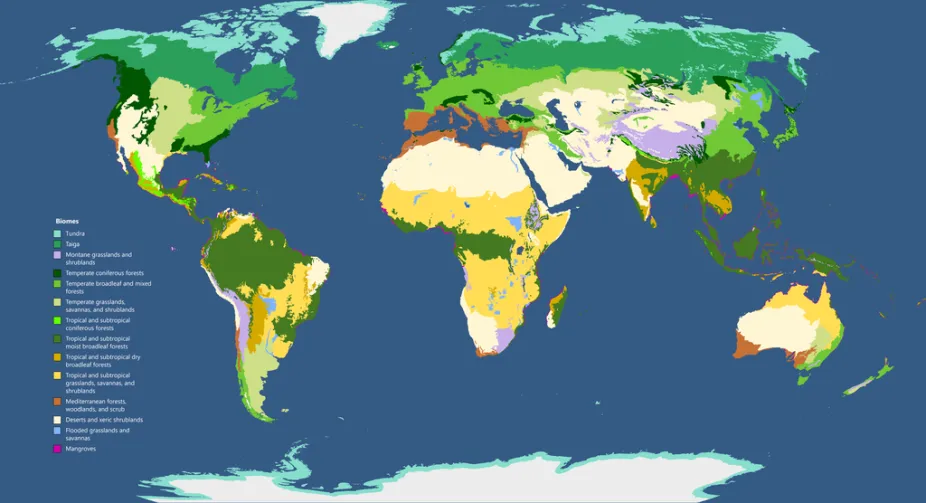The Earth’s Major Life Zones: A Deep Dive into Global Biomes
A biome represents a vast ecological community of flora and fauna adapted to a specific climate and geography. [1][2] These life zones, broadly categorized into terrestrial (land-based) and aquatic (water-based) systems, form the fundamental framework of the biosphere. [1][3] The distribution and inherent characteristics of each biome are dictated by abiotic factors, primarily temperature and precipitation, which in turn shape the evolution of life within them. [3][4] Understanding these expansive ecosystems is critical, as they harbor the planet’s biodiversity, regulate global climate patterns, and provide essential resources for human sustenance. [1]
Terrestrial Biomes: Ecosystems Forged by Climate and Land
Terrestrial biomes are primarily defined by their dominant vegetation, which is a direct reflection of the regional climate. [5] From the frigid poles to the hot, humid equator, these land biomes showcase a remarkable diversity of life and adaptive strategies. The tundra, found in the Arctic and on high mountain elevations, is the world’s coldest biome, characterized by a treeless landscape and a layer of permanently frozen soil known as permafrost. [6][7] This permafrost is a critical feature, as it contains vast stores of carbon in the form of frozen organic matter. [7][8] As global temperatures rise, the thawing of permafrost is a significant concern, as it releases potent greenhouse gases like carbon dioxide and methane, creating a feedback loop that accelerates climate change. [6][7] Just south of the tundra lies the taiga, or boreal forest, the world’s largest terrestrial biome. [9] Dominated by coniferous trees like pines, spruces, and larches, the taiga is a colossal carbon sink, storing more carbon in its soils and wetlands than temperate and tropical forests combined. [9][10] This biome’s ability to sequester carbon is under threat from warming temperatures, which increase the risk of pest outbreaks and large-scale wildfires that could release enormous quantities of stored carbon. [9][11]
In the mid-latitudes, temperate biomes display distinct seasonality. [12] Temperate deciduous forests, found in regions like eastern North America, Europe, and East Asia, are characterized by broad-leaved trees that shed their foliage in the fall. [13][14] The decomposition of these fallen leaves creates exceptionally fertile soils, rich in organic matter, which has historically made these areas prime for human settlement and agriculture. [13][15] These forests support a high diversity of life adapted to the changing seasons. [13] Temperate grasslands, known as prairies in North America, steppes in Eurasia, and pampas in South America, are dominated by grasses and have few trees due to lower precipitation levels. [16] Their soils are among the most nutrient-rich on Earth, a result of the dense root systems of grasses that create a thick layer of humus. [16][17] This inherent fertility has led to the conversion of vast grassland areas into the world’s most productive agricultural lands, a practice that also poses threats of soil degradation and biodiversity loss if not managed sustainably. [16][17] The chaparral, or Mediterranean biome, is adapted to hot, dry summers and mild, wet winters. [18][19] Its vegetation is dominated by drought-resistant, sclerophyllous (hard-leaved) shrubs that are uniquely adapted to periodic, high-intensity fires, with many species requiring fire to trigger seed germination or to resprout. [18][20]
Closer to the equator, tropical biomes are defined by consistently warm temperatures. Tropical rainforests are bastions of biodiversity, housing more species than all other terrestrial biomes combined. [21] They feature a stable, hot, and wet climate year-round, which supports a dense, multi-layered canopy of evergreen trees. [3][21] In contrast, savannas are grasslands with scattered trees, experiencing distinct wet and dry seasons. [21] This environment supports vast herds of large herbivores and their predators, with fire playing a crucial ecological role in maintaining the balance between grasses and trees. Deserts, defined by their extreme aridity (receiving less than 25 centimeters of rain annually), showcase life’s remarkable resilience. [21][22] Organisms here have evolved extraordinary adaptations to conserve water, such as the nocturnal behavior of many animals to avoid daytime heat and the water-storing stems of succulent plants like cacti. [23][24]
Aquatic Biomes: The Dominant Realm of Water
Covering approximately 75% of the Earth’s surface, aquatic biomes are the planet’s largest and are divided into two main groups: freshwater and marine. [25] Unlike terrestrial biomes, the primary limiting factors here are not just temperature but also the availability of sunlight, and the concentration of dissolved oxygen and nutrients. [26] The marine biome, encompassing the oceans, coral reefs, and estuaries, is characterized by its high salt content. [27][28] It is zoned by depth and distance from land, creating diverse habitats from the sunlit photic zone, where photosynthesis occurs, to the dark, high-pressure abyssal zone of the deep ocean. [29][30] Marine algae are a cornerstone of global health, supplying a significant portion of the world’s oxygen and absorbing vast amounts of atmospheric carbon dioxide. [30] Biodiversity hotspots, such as coral reefs and the Mesoamerican Barrier Reef System, support a disproportionately high number of marine species, making them critical priorities for conservation. [31][32]
Freshwater biomes, which have a low salt concentration, include rivers, streams, lakes, and wetlands. [26][27] These ecosystems are vital, providing drinking water and supporting a wide array of life, from microscopic plankton to fish and amphibians. [27][33] Lakes and ponds are classified as standing water (lentic systems), while rivers and streams are flowing water (lotic systems). [34] The characteristics of freshwater biomes are heavily influenced by the surrounding terrestrial environments, which affect water flow, temperature, and nutrient input. [25] Both marine and freshwater biomes are under significant threat from pollution, habitat destruction, and climate change, which alters water temperature and chemistry, endangering the delicate balance of life within them. [35]



